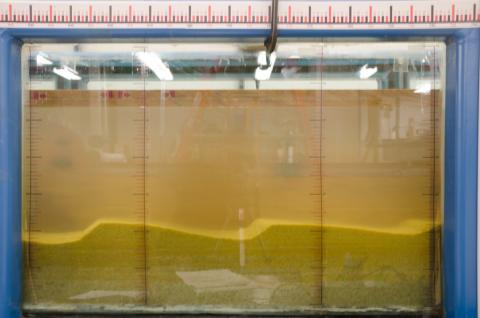Table of Contents
1 Location:
2 Descriptions
Experiments in high-intensity bedload transport of uniform sediment (in upper-plane bed regime and sheet flow regime) are being conducted in the
3 Specifications
3.1 Dimensions
- Length of experimental reach: 8.90 m
- Width: 0.19 m
- Depth: 0.60 m
3.2 Structure
- Frame: Steel
- Walls: Glass on one side, plywood on the other.
3.3 Features
3.3.1 Tail gate downstream control
The downstream water elevation is controlled via a screw-operated aluminum sharp-crested weir. Current operation is manual. The gate has an integrated stepper motor to allow for future automation of its operation.
3.3.2 Sediment feeder
Sediment is supplied via a Schenk Accurate 600 feeder at the upstream end of the flume.
3.4 Water
3.4.1 Supply
A constant head tank supplies water to the flume via a 6-inch or an 8-inch supply line.
Two vertical pumps may also be used to provide high-flow, low-head discharge into the flume. Their use, at the moment, is deprecated in favor of the head tank.
Flow rates used for the experiment are 30 liters per second and 20 liters per second.
3.4.2 Discharge
Water is discharged back into the mail sump of the laboratory, at the outstream end of the flume via a 12-inch PVC pipe controlled by a butterfly valve. A 4-inch corrugated hose is also available for slower drainage rates.
Water is also discharged through the sediment trap whenever the sediment trap gate valve is open.
All discharges outflow into the main laboratory sump.
3.5 Sediment
3.5.1 Supply
Sediment is supplied via Schenk Accurate 600 feeder located at the upstream end of the flume.
Sediment feed rates range from 500 grams per minute to 20 kilograms per minute for uniform sediment of mean grain size diameter Dg = 1.11 mm.
3.5.2 Extraction
Sediment is extracted from the flume via a sediment trap located at x-coordinate 890 cm from the upstream end of the flume. The 4-inch sediment-trap discharge pipe outflows into a larger sediment trap, where water and sediment are separated before allowing the water to outflow back into the main laboratory sump.
3.5.3 Type of sediment
Sediment currently used for the experiment is uniform silica sand of mean grain size diameter of Dg = 1.11 mm.
4 Instrumentation
4.1 Rulers
Transparent rulers are attached to the flume windows for measuring water surface and bed elevation by visual inspection at intervals specified by opaque rulers attached to the flume's frame.
4.2 JSR Ultrasonic sonar pulser
Used for measuring instantaneous realizations of bed elevation fluctiations in the flume.
4.3 Nortek Vectrino II Acoustic Doppler Velocimeter
Used to measure flow velocity and velocity profiles.
4.4 Nikon D3000 DSLR camera with 18-200 mm lens
Used for capturing photographs and videos of the experiment.
